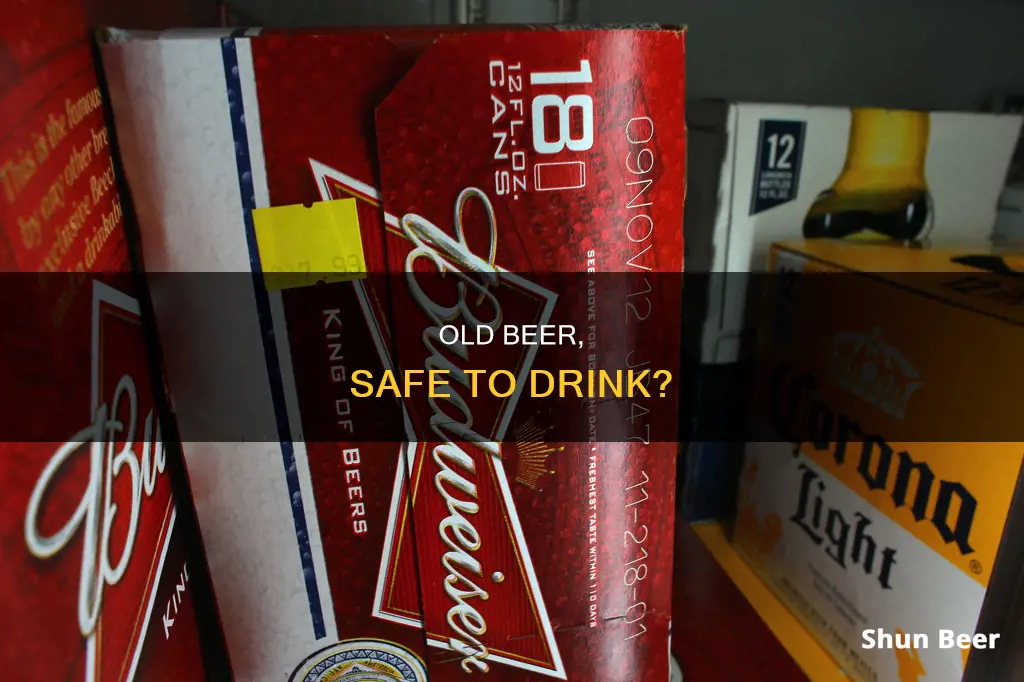
Drinking a 2-day-old beer is unlikely to make you sick, but it will probably taste stale and flat. Beer has a shelf life of around two days before it loses its flavour significantly. However, if you don't mind the taste, you can still drink it.
What You'll Learn

Is 2-day-old beer safe to drink?
It's important to note that the shelf life of beer depends on a variety of factors, including whether it's sealed or open, the type of beer, its alcohol content, and how it's stored.
Sealed beer can generally stay at optimal quality for about 4 to 6 months when stored at room temperature. However, once a beer bottle is opened, its freshness lasts for only 1 to 2 days. After that, the beer will likely lose its carbonation, flavour, and freshness, becoming "flat". While it's not dangerous to drink beer that's been left open for 2 days, it's important to consider the storage conditions and check for any signs of spoilage.
Proper storage is crucial to maintaining the quality and safety of beer. Beer should be stored in a cool, dry, and dark place, preferably in a refrigerator set at 35°F to 46°F. Exposure to UV rays, temperature fluctuations, and oxygen can accelerate the spoilage process, causing flavour deterioration and oxidation. Additionally, storing beer upright helps minimise the surface area exposed to oxygen, preserving freshness.
When it comes to 2-day-old open beer, it's generally safe to consume, but the taste may not be pleasant. Beer that has been left out for more than a day can develop an unpleasant flavour and may become flat. However, if the beer was refrigerated during this time, it may still be drinkable, although the quality and taste will likely be affected.
It's important to check for signs of spoilage before consuming any beer, especially if it has been left open for 2 days. Signs of spoilage include strange smells, such as a skunk-like or urine-like odour, unusual flavours like metallic, sour, or cardboard-like tastes, and cloudiness or mould growth in the beer. If any of these signs are present, it's best to discard the beer.
In summary, while 2-day-old beer may be safe to drink, it's important to consider storage conditions and check for any signs of spoilage. Properly stored beer within its recommended shelf life will maintain its quality and taste without risking health hazards.
Beer and Apple: A Delicious Pairing?
You may want to see also

How does beer taste change over time?
Beer is a beloved beverage for many, but its flavour profile can change over time. Several factors influence how beer tastes over time, and understanding these factors can help beer enthusiasts appreciate the nuances of this beverage and make informed decisions about purchasing, storing, and consuming beer.
Firstly, the ageing process affects beer's taste. Unlike wine, most beers do not improve with age. Commercial beers, especially light lagers, are typically meant to be consumed fresh and may start to deteriorate in quality after a few months. However, some craft beers, particularly those with higher alcohol content, can benefit from ageing and develop more complex flavours over time.
Secondly, exposure to oxygen plays a significant role in altering beer's taste. Oxidation can occur when beer comes into contact with oxygen, leading to flavour degradation and colour changes. Bottled beer is more susceptible to oxygen exposure than canned beer, and proper sealing and upright storage can help minimise this risk.
Temperature is another critical factor in the changing taste of beer. Serving temperature can mask or accentuate flavours and aromas. Beer served too cold can dull the taste buds' sensitivity, muting flavours and aromas. On the other hand, warm beer allows more flavours and aromas to emerge but may result in decreased hop bitterness and carbonation, leading to a flatter-tasting beer. Therefore, different beer styles have suggested serving temperature ranges to optimise their flavour profiles.
Additionally, UV rays from sunlight are known to shorten beer's shelf life. UV exposure triggers a chemical reaction that breaks down the taste components, leading to flavour deterioration. This is why beers are often packaged in dark bottles or cans, as they offer protection against UV rays.
Lastly, the drinking environment and serving vessel can also influence the taste of beer. For example, the shape of the glass can affect the release of aromatic compounds, temperature control, and nucleation sites. The context in which the beer is consumed, including the surroundings and one's company, can also impact the overall drinking experience and perception of taste.
In summary, the taste of beer can be influenced by various factors, including ageing, oxygen exposure, temperature, UV rays, and the drinking environment. Understanding these factors can help beer enthusiasts appreciate the complexities of beer's flavour profiles and make informed choices to optimise their beer-drinking experiences.
Budweiser Beverage: Alcoholic or Not?
You may want to see also

What are the signs of spoilt beer?
Beer is susceptible to a long list of potential problems that can affect the way you enjoy it. Here are some signs that your beer has gone bad:
Strange Smell
An unusual smell is a clear indication that your beer has gone bad. Skunky, urine, vinegar, or rotten egg-like odours are some of the common smells that indicate spoilage. These odours could be a result of bacterial growth or other microorganisms in the beer, which can make you sick if consumed.
Strange Taste
Strange tastes in your beer, such as metallic, sour, cardboard-like, or butterscotch flavours, are also signs of spoilage. These off-flavours can be caused by bacterial contamination or extended exposure to oxygen. Diacetyl, a buttery-tasting compound, is naturally produced during beer fermentation, but excessive amounts can result in an artificial butter or butterscotch flavour, indicating spoilage.
Cloudiness
Cloudiness or haziness in beer can be a sign of bacterial contamination. Bacteria can cause proteins and other compounds to clump together, resulting in a cloudy appearance. However, it is important to note that not all cloudy beers are spoiled, as some craft beers may have a hazy appearance for flavour and texture.
Mold Growth
Although it is rare for unopened beer to have mold due to its alcohol content and low pH level, issues during the bottling or canning process can result in mold growth. If you notice any signs of mold, it is best to discard the beer as consuming it can be harmful.
Loss of Carbonation
A loss of carbonation in your beer can indicate spoilage. This can happen when wild yeast or bacteria get into the beer and continue the fermentation process, resulting in excess carbon dioxide and a "gusher" effect.
It is important to note that the shelf life of beer depends on various factors, including temperature, exposure to light and oxygen, and whether it is opened or sealed. To extend the shelf life of your beer, it is recommended to store it in a cool, dark, and airtight environment.
Beer and Oral Thrush: Is There a Connection?
You may want to see also

How to extend the shelf life of beer?
Beer can be safely consumed past its "Best Before" date, but its taste and quality will deteriorate over time. The shelf life of beer depends on several factors, including the type of beer, packaging, temperature, and exposure to light and oxygen. Here are some tips to extend the shelf life of beer:
Find the Perfect Storage Spot
The ideal storage temperature for beer is between 35 and 55 degrees Fahrenheit (2 to 13 degrees Celsius). Avoid areas with temperature fluctuations, such as near windows or heating vents. Keep the beer away from direct sunlight and UV rays, as they can cause spoilage and affect the taste. If possible, store beer in a refrigerator to slow down flavour degradation.
Keep the Beer Sealed and Upright
Properly seal beer bottles or cans after opening to prevent oxygen exposure, which can cause the beer to spoil faster. Store beer upright rather than on its side to minimise the surface area exposed to oxygen, preserving its freshness.
Avoid Temperature Fluctuations
Avoid exposing beer to rapid temperature changes, as it can negatively impact its quality and taste. Do not freeze and thaw beer, as it affects carbonation levels and facilitates spoilage. If storing outdoors, choose a shaded area with stable temperatures. Use a cooler or insulated bag to protect the beer from extreme temperatures during transport.
Choose the Right Container
The type of container also affects the shelf life of beer. Canned beer generally lasts longer than bottled beer because cans block out light, slowing down the oxidation process. Dark bottles offer better protection against UV rays than clear or light-coloured bottles.
Consider the Beer Type
The variety of beer also plays a role in its shelf life. Lighter beers, such as pale ales, wheat beers, lagers, and IPAs, should be consumed within three months of packaging. Heavier beers like stouts and porters have a longer shelf life of about six months. Barrel-aged beers, including sour ales and imperial beers, can benefit from longer storage, as they have higher alcohol content and their flavours continue to evolve.
Gluten Allergy and Beer: What's Safe to Drink?
You may want to see also

What to do with leftover open beer?
Beer is considered "'flat' when its carbonation level rises above a certain point, usually after being left open for a day or two. Flat beer lacks the bitterness and sharpness that define good beer. It will also have an unpleasant, stale flavour.
While drinking flat beer is unlikely to make you ill, it can ruin your sense of taste and leave you with a stomachache. If you're set on drinking it, it's best to consume it within 24-48 hours of opening.
If you're not keen on drinking it, there are several other things you can do with leftover beer:
- Make beer cheese by mixing cheddar cheese and cream cheese with garlic, red pepper flakes, spring onions, Worcestershire sauce, salt, and pepper.
- Simmer leftover beer with celery, potatoes, and onions to make a tasty beer soup.
- Make an unforgettable feast by using your leftover beer to make beer-battered fish.
- Use it to make beer bread.
Drinking and Driving: Is it Ever Safe?
You may want to see also
Frequently asked questions
Yes, you can drink a 2-day-old beer without exposing yourself to health risks. However, it will likely be flat and lack its initial flavour.
An open beer can be kept for up to a week if stored properly. However, it's important to test for indicators of spoilage, such as an unpleasant flavour, a musty smell, or visible mould.
Leaving a beer out overnight will not expose you to health risks, but it will likely be flat and lack its original flavour.
Spoiled beer will develop a strange smell, such as skunk or urine, and may have unusual flavours like metallic, sour, or cardboard-like tastes. It may also appear cloudy or have visible mould growth.







